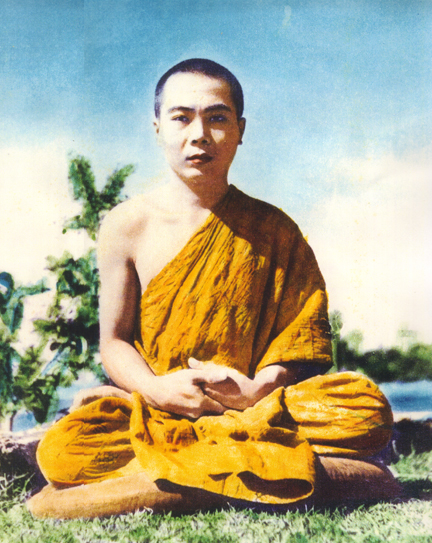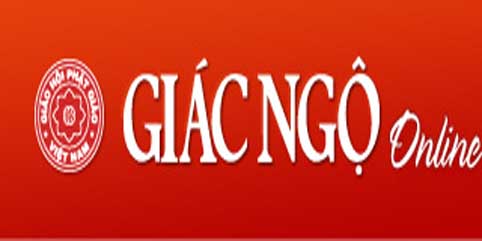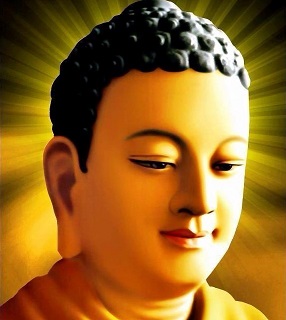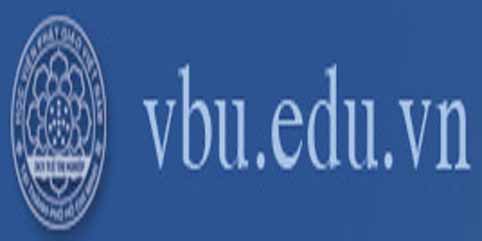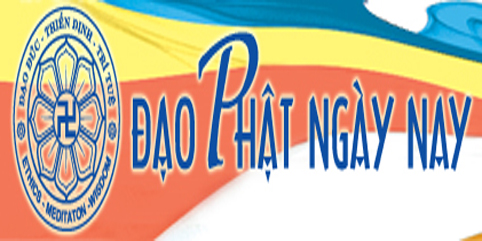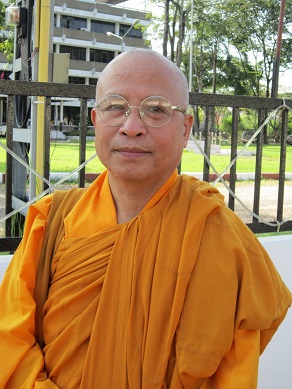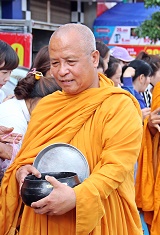Trang nhất » Tin Tức » ENGLISH
THE FIRST, THE SECOND, THE THIRD BUDDHIST COUNCIL
Chủ nhật - 15/10/2017 13:58THE FIRST BUDDHIST COUNCIL
All the schools hold that, there was a council held at Rajagaha in the second month of the first rainy season, about 90 days after Buddhas’s Mahaparinibbana. This council was held at Sataparni cave in Rajagaha, the capital of king Ajatasatu.
It’s a general agreement that there were 500 Arahants collection the council, the venerable Mahakassapa was president of the assembly in, which ven Upali and Ananda took an important part.
When hearing imformation about the Mahaparinibbana of the Buddha, every monks became sorrow. Then ven Subhadda said to that : “Do not grieve, do not lament. We are happy to get rid of Mahasamsana now. We shall be able to do what we like, and what we don’t like, we shall not have to do”. He exhorted monks to refrain from expressing grief and called upon them to think of good riddance. This irreverent remark come to ven Mahakassapa, he felt worry for the future of Dhamma.This is the first cause of this council.
The second reason was that many monks thought when the Lord passed away, Dhamma will disappear also. This general feeling of doubt and consternation was the motive of the council.
One more another reason was ven Mahakassapa wanted to prevent the public opinion that Buddha’s disciples only kept precept when the master was alive. Thus, the council was held to preserve the purity of the Dhamma as well as to consolidate the Sangha.
It was said that, at first Ananda was not allowed to participate the council, because he was not an Arahant. Which his effort in cultivation on night before the beginning of the council he attainted Arahanthood.
The second trouble for Ananda many monks arraigned him on several charges and he explained as follows :
1. He could not formulate the lesser and minor precepts because he was over whelmed with grief at the imminent death of the Master.
2. He had to tread upon the garment of the Master while sewing it, as there was no one to help him.
3. He permitted women to salute first the body of the Master because he did not went to detain them.
4. He was under the influence of Mara when he forgot to request the Master to enable human being to continue his study for a kalpa.
5. He had to asked for the admission of women into the Sangha out of consideration for Mahaprajapati Gotami who had nursed the Master in his infancy.
6. As the water of the river was muddy, he did not supply the same to the Buddha.
7. He showed the privy parts of the Buddha to men and women of low character with a purpose to rid their sensuality.
When Ananda explained these above points, the assembly agree him to join the council.
The procedure of this council was so simple with the permission of the sangha ven Mahakassapa asked question on the vinaya of ven Upali and on the 5 Nikayas of ven Ananda. In this way, Vinaya pitaka and sutta pitaka were composed during the time of seven months of the council.
An other point mentioned in this council was the punishment to Channa, who was the charioteer of the Master on the Great renunciation because he had slighted members of order and was arrogant in the extreme. Then Channa falt repentance grief and he improved his weakness in short, he became an Arahant.
During this time, Abhidhamma was not composed, sutta pitaka and vinaya pitaka were composed carefully by two Arahants who accepted directly from the Buddha.
It can be said that, the first council was held in proper time, so that sangha could be consolidated well.The teachings of the Buddha also should be reestablished
In short, the proceedings of the First Council achieved four results:
- The settlement of the Vinaya under the leadership of Upali.
- The settlement of the texts of the Dhamma under the leadership of Ānanda.
- The trial of Ānanda.
- The punishment of Channa.
The First Council was held under the support from King Ājatasattu.
THE SECOND BUDDHIST COUNCIL
The second council was held at Vesali a century after the passing of the Mater. According to Cullavagga, the monks of the Vajji region had got the habit of following the Ten Extravagances mentioned below :
1. Singilonakappa : it was the practice of carrying salt in a horn.
2. Dvangulakappa: the practice of taking meals when the shadow is two fingers broad.
3. Gamantarakappa: the practice of going to another village and taking a second meal there on the same day.
4. Avasakappa : the observance of the Uposatha ceremonies in various places in the same parish.
5. Anumatikappa : obtaining sanction for a deed after it is done.
6. Acinnakappa : using customary practices as precedents.
7. Amathitakappa : the drinking of buttermilk after meals.
8. Jalogim-patum : the drinking of toddy
9. Adasakam-nisidanam : using a rug which has no fringe.
10. Jataruparajatam : the acceptance of gold and silver
Yasa felt that these Ten Extravagances were unorthodox, illegal and immoral in the extreme. The Vajji monks, however, imposed the penalty of Patisaraniyakamma upon him. This required the offender’s apologizing to the laity who had been forbidden by Yasa to carry out the precepts of the Vajji monks. Yasa successfully defended his own view before the laity and by his persuasive argument won them over to his side. This increased the fury of the offending monks who proclaimed the penalty of Ukkhepaniyakamma upon him, which meant his literal expulsion from the Sangha.
After the penalty of expulsion had been imposed on him, he went to Kausambi and sent messengers to the Bhikkhus of the Western country and of Avanti and of the Southern country, inviting them to assemble and decide the question in order to arrest the growth of irreligion and ensure the preservation of the Vinaya.
Next, he travelled to the Ahoganga hill where Sambhuta Sanavasi was dwelling. He saluted the venerable monk and expounded the Ten thesis advocated by the Vajjian monks. He invited him to take up this question in earnest. The Venerable Sanavasi agreed to do so. About the same time some sixty Arhants came from the Western country and assembled on the Ahoganga hill. About 88 from Avanti and the Southern country also joined them. These monks declared the question to be hard and subtle. They thought of the Ven. Revata who was at Soreyya and was celebrated for his learning and piety. They planned to meet him and enlist his support. After a good deal of traveling they met the Ven. Revata at Sahajati. On the advice of Sambhuta Sanavasi, he approached the Ven. Revata and put the matter before him. One by one, Bhikkhu Yasa brought up the Ten Points and asked for his opinion. Each one of them was declared to be unacceptable by the Ven. Revata.
Meanwhile, the Vajjian monks were also busy with their activities. They also went to Sahajati in order to enlist the support of the Ven. Revata. They offered him rich presents which the Ven. Revata refused with thanks. However, they induced his disciple, Uttar, to take up their cause, but he failed.
At the suggestion of Revata, the monks moved to Vesali in order to settle the dispute at the place of its origin. Seven hundred monks met in a Council, but there was much long-winded talk and futile discussion. In order to avoid further waste of time and irrelevant discussion, the matter was referred to a committee consisting of four monks from the East and four from the West. Bhikkhu Ajita was appointed the seat regulator. The Ven. Sabbakami was elected president. The Ten Points were put one by one and they were declared unlawful. The questions were stated again and the same decision was arrived at in the full assembly of the Council. The unanimous verdict of the assembly declared the conduct of Vijjian monks to be unlawful.
According to the Dipavamsa, the council was held in the reign of king Kalashoka, a descendant of Ajatasattu. Kalashoka though formerly in favour of the Vajjian monks, was later persuaded to give support to the council of the Thera.
The Dīpavamsa points out that the Bhikkhus of Vesalī convened another council in which Ten Thousand monks participated. It was called the Mahāsangīti (Great Council). According to Mahavamsa, a council of 700 theras compiled the Dhamma.
In spite of some small variations, there is considerable consensus on the origin of the Council and the subjects deliberated and resolved.
THE THIRD COUNCIL
The third council was held at Pāṭaliputtaunder the patronage of the renowned Buddhist emperor, Asoka. With the conversion of Asoka, the material well-being of the monasteries grew many-fold and the monks lived a life of affluence. The heretics who had squandered their income and honour were allured by these promises to enter the Buddhist Saṃgha. They continued, however, to stick to their old convictions and customs and pronounced their precepts as the doctrines of the Buddha. This resulted in intense agony to Thera Moggaliputta who retreated to a sequestered retreat on the Ahoganga Hill up the Gangā and dwelt there for seven years.
The number of heretics and false monks became far large than that of the true believers. As a result for seven years no Uposatha or Pavāraṇā ceremony was held in any of the monasteries. The faithful monks refused to observe these festivals with the heretics. This failure of the samgha distressed the Emperor greatly and he sent instructions for the observance of the Uposatha.
A tragic faux pas was made by the minister to whom this task was assigned. He misinterpreted the command and slaughtered several monks for their non compliance with the king’s order. When this matter was reported to Asoka he was overpowered with distress and sought pardon for this misdeed. He asked the samgha whether they held him accountable. Some thought him guilty, some not. The king was puzzled and queried if there was any among the monks who could set his doubts at rest. They all said that only There Moggaliputta Tissa could answer his question. Thereupon the king sent messengers to the monk asking him to come down to Pataliputta.
After several unsuccessful attempts, the Elder Tissa was prevailed upon to consent to come to Pāṭaliputta. He instructed the king in the holy religion of the Buddha for a week. The king thereafter convoked an assembly of the whole community of the monks. He called the Bhikkhus of several persuasions to his presence and asked them to expound the teachings of the Blessed One. They set forth their misguided beliefs, such as the doctrine of the eternal soul, and so on. The heretical monks numbering sixty thousands were expelled from the Saṃgha by the king. He thereafter interrogated the true believers about the doctrine taught by the Blessed One and they answered that it was Vibhajjvāda (the religion of the analytical reasoning). When the Thera corroborated the truth of this answer, the king made the request that the samgha should hold the uposatha ceremony so that the whole community might be purified of evil elements.
The Thera was made the guardian of the Saṃgha. Thera Tissa thereafter elected a thousand bhikkhus of the Samgha who were well versed in the Tipitaka to make a compilation of the true doctrine. For nine months he worked with the monks and the compilation of the Tipitaka was completed. This council was held in the same manner and with the same zeal as those of Mahākassapa and thera Yasa respectively. In the midst of the council Thera Tissa set forth the Kathāvatthu-pakarṇawherein the heretical doctrines were throughly examined and refuted. It is now generally agreed that the Kathāvatthu was not composed enbloc. Its compilation was begun but not completed by Tissa.
Thus ended the third council in which a thousand bhikkhus took part. According to the Dīpavaṃsa, it was attended by 60,000 faithful followers of the Buddha. Together with Tissa, the Emperor asked them questions about the essence of the Buddha’s teachings, banished from the Saṃgha those who were proved heretic and asked the pious monks : “What did the Buddha preach ?”. In reply he heard : “He preached the teachings of Vibhajja”. Tissa confirmed the correctness of their words and the jubilant king, who believed that the Saṃgha had been purged of all heresy, went back to the capital, leaving Tissa as the champion of the unity of the Samgha. Now the monks were able to perform the ceremony of Uposatha.
One of important results of this council was the dispatch of missionaries to the different countries of the world for the propagation of the sadhamma. Mahinda and Saṃghamittāwere charged with missionary work in the island of Sri Lanka. We also know from other sources that Asoka sent missionaries to different parts of Asia, Africa and Europe. It it to a great extent due to these missionary activities that Buddhism became the ruling religion of a large part of mankind.
Những tin cũ hơn
•Tin Được Quan Tâm Nhiều
-
 Nhóm Thiện Nguyện Tịnh xá Ngọc Sơn ủng hộ từ thiện nhân mùa Phật Đản tại Ấn Độ.
Nhóm Thiện Nguyện Tịnh xá Ngọc Sơn ủng hộ từ thiện nhân mùa Phật Đản tại Ấn Độ.
Bố thí là nền tảng cơ bản để kết nối yêu thương, sẻ chia cuộc sống nhằm làm vơi bớt nỗi đau bất hạnh... -
 KHÓA TU MỘT NGÀY CHÁNH NIỆM NIỆM PHẬT TẠI TỊNH XÁ NGỌC SƠN.
KHÓA TU MỘT NGÀY CHÁNH NIỆM NIỆM PHẬT TẠI TỊNH XÁ NGỌC SƠN.
Vào lúc 8 giờ sáng ngày 21/10/2017 (nhằm ngày 2/9/ Đinh Dậu), khóa tu một ngày Chánh Niệm Niệm Phật... -
 Bữa cơm chuyển nghiệp lần 5
Bữa cơm chuyển nghiệp lần 5
Sáng ngày 12/10/2017 ( Nhằm ngày 23/8/ Đinh Dậu), chư tăng và Phật tử Tịnh xá Ngọc Sơn đã thân lâm... -
 Phát quà trung thu và trao học bổng cho các cháu thiếu nhi
Phát quà trung thu và trao học bổng cho các cháu thiếu nhi
Tết Trung thu là một trong những lễ hội truyền thống có ý nghĩa quan trọng trong đời sống văn hóa... -
 Chương trình đón mừng đại lễ Phật Đản PL. 2560 tại Tịnh xá Ngọc Sơn
Chương trình đón mừng đại lễ Phật Đản PL. 2560 tại Tịnh xá Ngọc Sơn
Vào lúc 18 giờ ngày 14/4/ Bính Thân, dưới sự chứng minh của TT. Giác Trí cùng chư tôn Đức Tăng, Ni,... -
 Đại lễ Khánh thành bảo tháp Xá lợi Phật - Tịnh xá Ngọc Sơn
Đại lễ Khánh thành bảo tháp Xá lợi Phật - Tịnh xá Ngọc Sơn
Sáng ngày 7.4.2016 (01.3. Bính Thân) Tịnh xá Ngọc Sơn, xã Phước Sơn, huyện Tuy Phước, tỉnh Bình Định... -
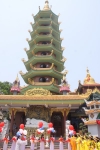 Công trình Bảo tháp xá-lợi ở TX. Ngọc Sơn
Công trình Bảo tháp xá-lợi ở TX. Ngọc Sơn
Nhằm tạo điều kiện cho mọi người không đủ phước duyên đến các nước để chiêm bái xá-lợi, Thượng tọa... -
 Lễ khánh thành bảo tháp thờ xá lợi Phật tại Tịnh xá Ngọc Sơn
Lễ khánh thành bảo tháp thờ xá lợi Phật tại Tịnh xá Ngọc Sơn
Ngày 7/4/1016 (nhằm ngày 01/3 năm Bính Thân), PL. 2559 tại Tịnh xá Ngọc Sơn, xã Phước Sơn, huyện Tuy...
•Tập San Đuốc Sen
-
 Nhóm Thiện Nguyện Tịnh xá Ngọc Sơn ủng hộ từ thiện nhân mùa Phật Đản tại Ấn Độ.
Nhóm Thiện Nguyện Tịnh xá Ngọc Sơn ủng hộ từ thiện nhân mùa Phật Đản tại Ấn Độ.
Bố thí là nền tảng cơ bản để kết nối yêu thương, sẻ chia cuộc sống nhằm làm vơi bớt nỗi đau bất hạnh... -
 KHÓA TU MỘT NGÀY CHÁNH NIỆM NIỆM PHẬT TẠI TỊNH XÁ NGỌC SƠN.
KHÓA TU MỘT NGÀY CHÁNH NIỆM NIỆM PHẬT TẠI TỊNH XÁ NGỌC SƠN.
Vào lúc 8 giờ sáng ngày 21/10/2017 (nhằm ngày 2/9/ Đinh Dậu), khóa tu một ngày Chánh Niệm Niệm Phật... -
 Bữa cơm chuyển nghiệp lần 5
Bữa cơm chuyển nghiệp lần 5
Sáng ngày 12/10/2017 ( Nhằm ngày 23/8/ Đinh Dậu), chư tăng và Phật tử Tịnh xá Ngọc Sơn đã thân lâm... -
 Phát quà trung thu và trao học bổng cho các cháu thiếu nhi
Phát quà trung thu và trao học bổng cho các cháu thiếu nhi
Tết Trung thu là một trong những lễ hội truyền thống có ý nghĩa quan trọng trong đời sống văn hóa... -
 Chương trình đón mừng đại lễ Phật Đản PL. 2560 tại Tịnh xá Ngọc Sơn
Chương trình đón mừng đại lễ Phật Đản PL. 2560 tại Tịnh xá Ngọc Sơn
Vào lúc 18 giờ ngày 14/4/ Bính Thân, dưới sự chứng minh của TT. Giác Trí cùng chư tôn Đức Tăng, Ni,... -
 Đại lễ Khánh thành bảo tháp Xá lợi Phật - Tịnh xá Ngọc Sơn
Đại lễ Khánh thành bảo tháp Xá lợi Phật - Tịnh xá Ngọc Sơn
Sáng ngày 7.4.2016 (01.3. Bính Thân) Tịnh xá Ngọc Sơn, xã Phước Sơn, huyện Tuy Phước, tỉnh Bình Định... -
 Công trình Bảo tháp xá-lợi ở TX. Ngọc Sơn
Công trình Bảo tháp xá-lợi ở TX. Ngọc Sơn
Nhằm tạo điều kiện cho mọi người không đủ phước duyên đến các nước để chiêm bái xá-lợi, Thượng tọa...
•Chia Sẻ Cùng Bạn Đọc
-
 Văn cảm tưởng về Thầy nhân mùa Vu Lan Báo Hiếu
Văn cảm tưởng về Thầy nhân mùa Vu Lan Báo Hiếu
Hôm nay nhân mùa Vu lan báo hiếu, Thầy cho chúng con được dâng lên lời cảm niệm này, thành kính cúng... -
 CLB Tình nguyện Sen Hồng sinh hoạt buổi đầu tiên
CLB Tình nguyện Sen Hồng sinh hoạt buổi đầu tiên
Ngày 17/4/2016, dưới sự chứng minh của HT. Giác Pháp - Chủ nhiệm Câu lạc bộ Tình nguyện Sen Hồng,... -
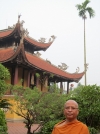 Ông Bụt của tôi
Ông Bụt của tôi
-
 Giá trị của công việc
Giá trị của công việc
Một chàng trai trẻ vừa tốt nghiệp Đại học loại xuất sắc nộp đơn dự tuyển vào vị trí quản lý cấp thấp... -
 Giá trị của cuộc sống
Giá trị của cuộc sống
Cuộc sống luôn 'nói chuyện' với ta qua những điều giản dị và không ngờ đến nhất.
•Hình Ảnh Tịnh Xá Ngọc Sơn
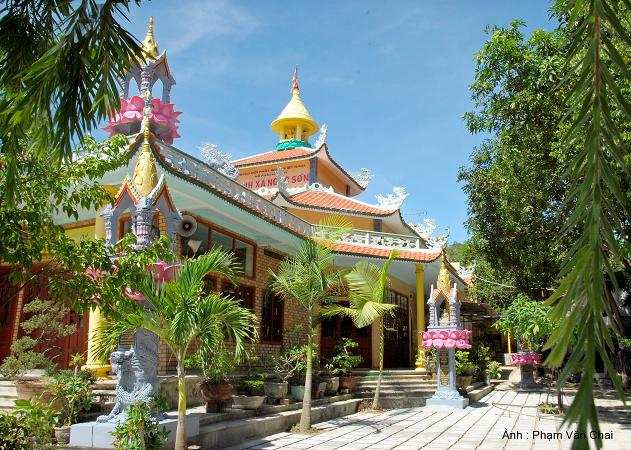 |
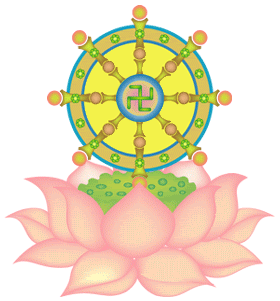 |

 Xem phản hồi
Xem phản hồi Gửi phản hồi
Gửi phản hồi